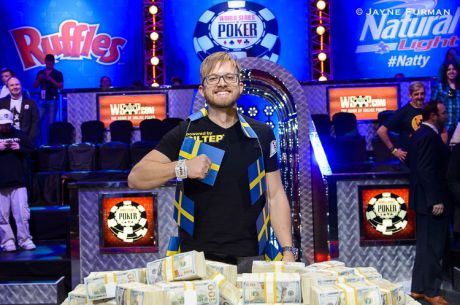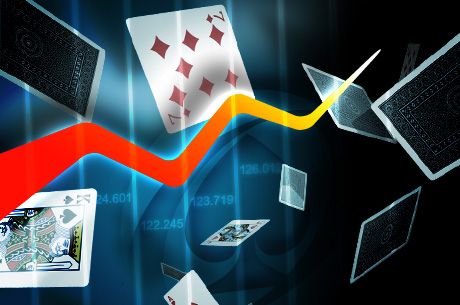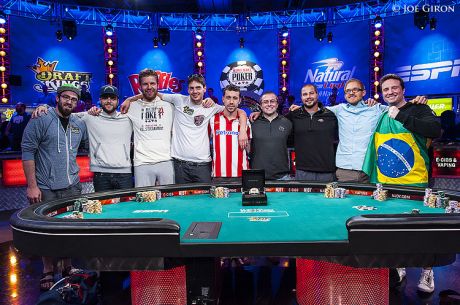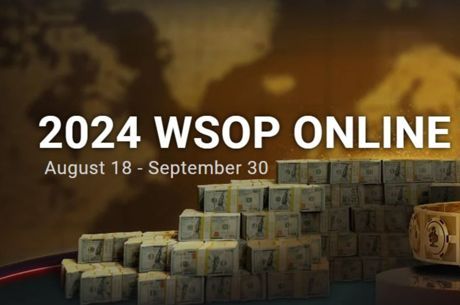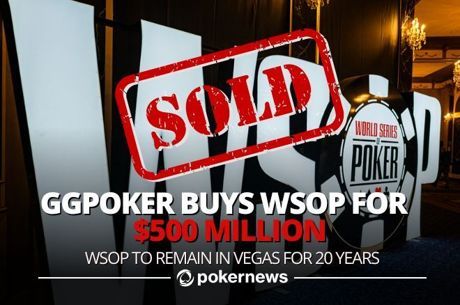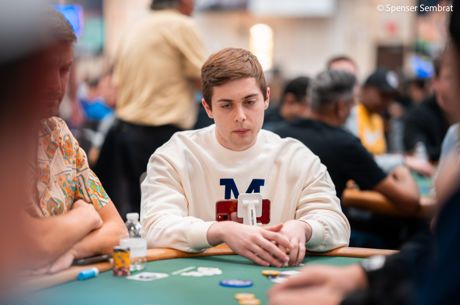By the Numbers: A Look Back at the 2014 WSOP Main Event Final Table
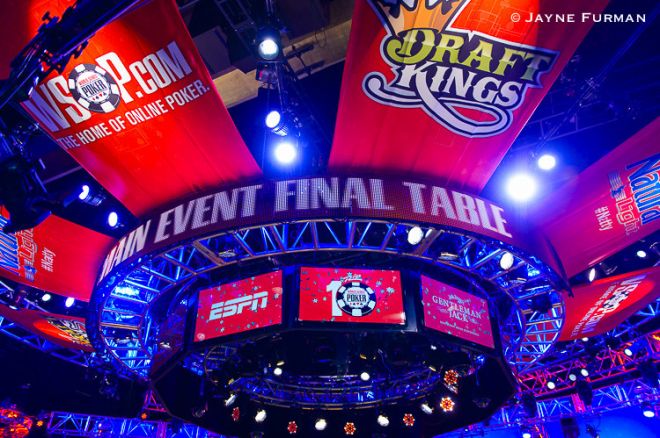
If you're anything like us here at PokerNews �� and we're sure you are if you're reading this article �� then you're a poker geek at heart. That's why we've decided to take a deeper look into the 2014 World Series of Poker Main Event final table from a statistical perspective.
In this article, you will find an in-depth look at the final table. PokerNews reported every single hand of the event, and we took the time to go through it all. From hands played to preflop five-bet percentage, we've got it all covered. We've also got a bunch of other interesting little tidbits of information for everyone to eat up, so let's get to it.
The first thing we'd like to look at is the amount of hands played at each final table in the November Nine era, which dates back to 2008.
| Year | Avg. Chips | Avg. BBs | Hands from Nine to Three | Hands from Three to Two | Heads-Up Hands | Total Hands |
|---|---|---|---|---|---|---|
| 2014 | 22,275,000 | 55.7 | 244 | 49 | 35 | 328 |
| 2013 | 21,186,000 | 53.0 | 170 | 1 | 90 | 261 |
| 2012 | 21,997,000 | 73.3 | 135 | 247 | 17 | 399 |
| 2011 | 22,881,000 | 45.7 | 178 | 4 | 119 | 301 |
| 2010 | 24,403,000 | 48.8 | 188 | 31 | 43 | 262 |
| 2009 | 21,652,000 | 90.2 | 271 | 5 | 88 | 364 |
| 2008 | 15,207,000 | 63.4 | 155 | 14 | 105 | 274 |
This table shows that the 2014 WSOP Main Event final table played the third most hands since the November Nine concept came about, with only 2009 and 2012 playing more. In 2012, Greg Merson, Jesse Sylvia, and Jake Balsiger played a very long three-handed match of 247 hands before Balsiger bowed out in third place. It's also important to note that in 2009, the amount of starting chips was increased from 20,000 to 30,000 in the WSOP Main Event.
To look at each player's statistics, we've first broken up the two playing days, Monday and Tuesday, on two separate tables. This will allow us to see if play changed at all for the final three that advanced to Tuesday, as the dynamic on Monday playing from nine down to three was a little bit different than the short-handed affair that took place on Tuesday. You'll also find a third table combining all of the stats for each player.
- Hands Played: This is the amount of hands dealt to each player.
- VPIP%: The percentage a player voluntarily puts chips into the pot preflop. This includes raising, calling, and completing from the small blind, but does not include checking the option from the big blind. The higher the VPIP%, the more active the player.
- PFR%: The percentage of time a player entered the pot with the first raise.
- PF 3B%: The percentage of time a player entered the pot with the third raise (a reraise). Keep in mind that the big blind counts as the first raise.
- PF 4B%: The percentage of time a player entered the pot with a fourth raise.
- PF 5B%: The percentage of time a player with a fifth raise.
- PW w/o SD: The number of pots won by a player without showdown.
- Pots Won at Showdown: The number of pots won after going to a showdown. This includes all all-in hands that were won by the player.
Monday: 244 Total Hands Played
| Player | Hands Played | VPIP% | PFR% | PF 3B% | PF 4B% | PF 5B% | PW w/o SD | PW SD |
|---|---|---|---|---|---|---|---|---|
| Billy Pappas | 209 | 16.27% | 8.61% | 2.87% | 0% | 0% | 17 | 5 |
| Felix Stephensen | 244 | 27.46% | 15.98% | 2.05% | 1.64% | 0% | 30 | 7 |
| Jorryt van Hoof | 244 | 34.84% | 24.18% | 4.51% | 0.82% | 0.41% | 56 | 6 |
| Mark Newhouse | 56 | 28.57% | 14.29% | 0% | 0% | 0% | 4 | 1 |
| Andoni Larrabe | 140 | 18.57% | 7.14% | 3.57% | 0% | 0% | 13 | 3 |
| William Tonking | 224 | 24.55% | 13.84% | 4.91% | 0.45% | 0% | 28 | 5.5 |
| Dan Sindelar | 106 | 28.30% | 14.15% | 3.77% | 0.94% | 0% | 10 | 2.5 |
| Martin Jacobson | 244 | 24.18% | 11.48% | 6.56% | 0.41% | 0% | 42 | 5 |
| Bruno Politano | 100 | 15.00% | 11.00% | 2.00% | 0% | 0 | 8 | 1 |
You'll notice from the numbers above that Jorryt van Hoof was by far the most active player at the final table. That should be of no surprise, as van Hoof came into the final table with a sizable chip lead and has a lot of experience in cash games where players tend to open up a little more when deep stacked. Van Hoof also had the highest preflop raise percentage and was the only player to five-bet. The most impressive stat is the amount of pots that van Hoof won without going to showdown in relation to the pots he won at showdown. Van Hoof secured 62 pots on Monday, and he won over 90 percent of those without going to a showdown.
Another very interesting thing we found involved the three players that made it to Tuesday's final day �� Martin Jacobson, Felix Stephensen, and van Hoof. Through the first 99 hands at the final table, when any of these three players won a pot, they did so without going to a showdown. Jacobson took most of his winning pots with either a preflop raise or three-bet, whereas Stephensen and van Hoof used superior skill in combination with their big chip stacks in the hands they played to not allow their opponents to get to a showdown. The first hand van Hoof won at showdown was on Hand #106 when he took out Dan Sindelar, and Jacobson didn't win a hand at showdown until Hand #145 when he doubled through William Tonking. Prior to that double up, Jacobson had won 16 hands without a showdown.
It was also interesting to find that Stephensen's first raise didn't come until Hand #28 of the final table, and this could very well be because of his position at the table. On his direct left was van Hoof with the chip lead, and he was playing active and aggressive. Mark Newhouse was two seats to his left and playing very active as well, so Stephensen seemed to settle in and feel out the dynamic of things. Jacobson, who entered the final table eighth in chips, wasn't the first player to open the pot with a raise until Hand #42, although he had three-bet before that.
Tuesday: 84 Total Hands Played
| Player | Hands Played | VPIP% | PFR% | PF 3B% | PF 4B% | PF 5B% | PW w/o SD | PW SD |
|---|---|---|---|---|---|---|---|---|
| Felix Stephensen | 84 | 60.71% | 30.95% | 5.95% | 1.19% | 0% | 28 | 5 |
| Jorryt van Hoof | 49 | 61.22% | 36.73% | 14.29% | 2.04% | 0% | 12 | 3 |
| Martin Jacobson | 84 | 51.19% | 25.00% | 8.33% | 1.19% | 0 | 30 | 6 |
On the second day of play, three players returned. The vibe was that van Hoof, who entered with the chip lead, would be hard to overcome given how well he played on Monday. But, many felt the momentum was with Jacobson, who was second in chips and came on strong late on Monday. Again, van Hoof played a lot of hands that he was dealt, but this time things didn't go his way. He soon fell to the short stack and was eliminated in third place. Of the 49 hands dealt to van Hoof, he voluntarily put chips in on 30 of them, aggressively raising or reraising on 26 of those 30.
Jacobson voluntarily put chips in on just over half of the hands he was dealt, which was the lowest of the final three players. This was similar to how he performed on Monday, where Jacobson voluntarily put chips in the lowest percentage of the time he was dealt a hand amongst the final four players. When you couple that with the fact that Jacobson won the second most pots without showdown on Monday and the most pots without showdown on Tuesday, it shows how efficient the Swede was �� with efficiency being judged on patience and effectiveness.
Total: 328 Total Hands Played
| Player | Hands Played | VPIP% | PFR% | PF 3B% | PF 4B% | PF 5B% | PW w/o SD | PW SD |
|---|---|---|---|---|---|---|---|---|
| Billy Pappas | 209 | 16.27% | 8.61% | 2.87% | 0% | 0% | 17 | 5 |
| Felix Stephensen | 328 | 35.98% | 19.82% | 3.05% | 1.52% | 0% | 58 | 12 |
| Jorryt van Hoof | 293 | 39.25% | 26.28% | 6.14% | 1.02% | 0.34% | 68 | 9 |
| Mark Newhouse | 56 | 28.57% | 14.29% | 0% | 0% | 0% | 4 | 1 |
| Andoni Larrabe | 140 | 18.57% | 7.14% | 3.57% | 0% | 0% | 13 | 3 |
| William Tonking | 224 | 24.55% | 13.84% | 4.91% | 0.45% | 0% | 28 | 5.5 |
| Dan Sindelar | 106 | 28.30% | 14.15% | 3.77% | 0.94% | 0% | 10 | 2.5 |
| Martin Jacobson | 328 | 31.10% | 14.94% | 7.01% | 0.61% | 0% | 72 | 11 |
| Bruno Politano | 100 | 15.00% | 11.00% | 2.00% | 0% | 0 | 8 | 1 |
It would be very, very interesting to be able to see every single hand dealt to every player at the final table, but unfortunately we only have a small sample of the total hands to go off of from the broadcast. Looking at the total numbers, though, a couple things stick out.
Going around the table in seat order �� which is how the above tables are displayed from top to bottom with the players �� Billy Pappas played snug and relatively passive, acting as the preflop aggressor 11.48 percent of the time with either an opening raise or reraise. Stephensen played the second highest percentage of hands he was dealt, and he was aggressive with a raise or reraise well over half the time. Stephensen exuded a lot of skill and poise that seemed to be a product of his cash-game background, and he did well after coming into the final table second in chips.
Van Hoof was by far the most active player at the final table, voluntarily entering the pot on nearly 40 percent of the hands he was dealt. He was aggressive when he did so, and he was also the only player at the final table to five-bet. Newhouse was also highly active, but he was much more on the passive side than van Hoof. Whereas van Hoof raised or three-bet preflop 32.42 percent of the time, Newhouse did the same just 14.29 percent of the time. In fact, Newhouse didn't once three-, four-, or five-bet. His willingness to play loose and lack aggression might've cost Newhouse, as he once again bowed out in ninth place �� this time after entering the final table third in chips.
Andoni Larrabe played an interesting game, flatting both pocket aces and pocket queens preflop at the final table. He voluntarily played under a fifth of the hands he was dealt and only acted as the preflop aggressor just over 10 percent of the time. Larrabe was able to work his way to a sixth-place finish, but one might ask what could've been had he played a bit more aggressive.
The quiet Tonking sure made some early noise at the table, busting Newhouse in ninth place and shooting himself up into the lead. Tonking played just about a quarter of the hands he was dealt and was a bit more aggressive than Larrabe. For those of you who weren't able to see the final table in action, after Tonking reached the chip lead and things seemed like they were all going his way, after one of the breaks the man from New Jersey came back to the table noticeably more tired. It was at this point that his stack began to decline and he couldn't get much going. Tonking did ride it out to a fourth-place finish, but we can strongly suggest that lack of endurance kept him from an appearance in Tuesday's final three.
Sindelar played fairly active in his time at the final table, which came to an end in seventh place. He seemed to be playing well, but sometimes in poker certain things just don't go your way. Once Tonking got a bigger stack, Sindelar had arguably the best seat at the table, with all the bigger stacks to his right, and the three shorter stacks to his left. Some have suggested he could've taken advantage of his seat a little more with increased aggression, but it also doesn't help when you lose with pocket jacks to ace-three for your tournament life. It would've been real interesting to see the dynamic of the table if Sindelar were to double on that hand instead of bust.
Jacobson seemed the most focused out of anyone at the final table, and his early play mirrored that. He kept his head above water early on with several preflop three-bets that went uncalled to allow him to chip up here and there. Watching the broadcast, Jacobson always seemed to have a good hand when he three-bet or three-bet shoved, but he was also picking very good spots to take advantage of the other players at the table trying to open up their game with bigger stacks. The first hand he won at showdown at on Hand #145 when he doubled through Tonking. Before that? He won 16 pots without showdown. Jacobson had the highest three-bet percentage at the final table, which lends itself to how focused in he was to take advantage of his opponents' aggression.
Bruno Politano played snug, and it was almost too snug. Not only did the Brazilian take 15-30 seconds with each preflop decision to give off the image of a scared, tight player, but the hands he did play seemed timid. There was no doubt that the other players at the table picked up on that and either took advantage of his tight image with aggression or backed off when Politano showed signs of a strong hand. Out of all the players at the final table, Politano had the most specific tight-aggressive image, playing just 15 percent of hands and raising or three-betting 13 percent of the time.
Get all the latest PokerNews updates on your social media outlets. Follow us on Twitter and find us on both Facebook and Google+!

